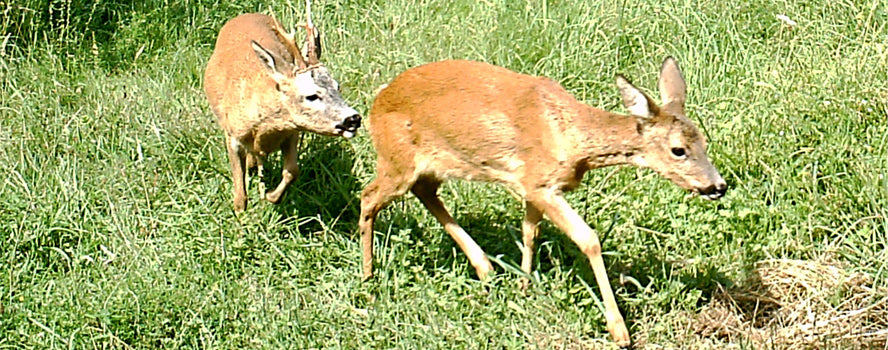Leaf Hunting Basics I : Fundamentals and Calling Signals

Leaf Hunting Basics - Part 1: Basics and Calling Signals
Text & images: Johannes Maidhof // Instagram: barbarossa.hunting
The leaf season holds many a myth: unknown bucks, driving bucks, squealing bucks make the heart of every roe deer hunter beat faster. When the air cools down in the evening after hot days or a mild morning displaces the night, great hunting experiences await you in the summer hunting grounds. From the end of June, you can already observe hot-headed bucks chasing the female roe deer, often they are youngsters looking for their early luck. However, the time of the rut is not defined by pestering bachelors, but by the receptiveness of the bucks and narrow deer. In fact, the rutting balls of roe bucks produce reproductive semen as early as May. The advancing year boosts the release of hormones and if they let the bucks, many a buck would certainly complete the mating already in early summer.
The harassment of the female pieces out of this wantonness, which they evade by high escapes, has nothing to do with the actual hustle and bustle. For this includes a rutting goat that wants to be "conquered". She doesn't jump off, but lets herself drift and pulls the goat behind her with the seductive scent of hormones. This ritual can go on for hours, punctuated by languorous bleats. The "mating dance" then creates the so-called witch's rings in meadows, as a circular trail of the love quarry.

The rut of roe deer begins about 9 - 10 weeks after the fawns are set. As a rule, narrow roe deer can rut a little earlier. The actual rutting period is not the same as the rutting period, which can be divided into several phases. Around 1 August, most doe are in rut and are shod. Once this peak of the mating season has passed, the actual foliage period begins. Now the bucks move around and look for remaining bucks in rut. Therefore, the first two weeks of August are the peak of the foliage season, when the majority of the bucks are shod and the bucks are on the move. Experienced leaf hunters reminisce about their best leaf hunting experiences after 12 August, when the number of rutting bucks becomes smaller and smaller. If you are concerned with the pure fulfilment of your shooting plan, if you do not hunt selectively, you can of course take advantage of the complete rut and the preliminary skirmish when the bucks awaken from the idleness of the feist season. The leaf season in the classical sense, however, is for the selective hunt for a mature buck.
Here, a balanced sex ratio pays off. If you want to be successful in leaf hunting, you have to do your homework already in autumn of the previous year, when hunting female roe deer. If the "natural selection" is simply too large due to the unbalanced sex ratio, it will be difficult to persuade the buck to come, even with the most passionate tones from the loosener.

Whether traditional beech leaves, the foliage of other tree species, blades of grass, mouth bladders made of wood, plastic or horn as well as the widespread hand bladders - the range of luring instruments is very wide. Practised virtuosos even blow with their lips or on the back of their hands. The luring sounds can also be formed on a banknote. It is said to have helped to increase the tips of guided hunters by stating that a big buck can only be lured on a big note. If the sex ratio is right and they are in the right place at the right time, the correct sounds are less important; according to tradition, the buck will even jump at a squeaking bicycle chain or the creaking of the pulpit door.
Whichever lure you choose, the rutting sounds of the roe deer can be imitated with most variants after a little practice:

Fieplaut
This sound is independent of the rut, for example the goat calls its fawn.
PIA
The so-called PIA sound is the characteristic rutting sound. The goat is in rut and calls for a buck. Yearlings and small, perennial bucks in particular respond to this sound, sensing a quick chance to get ahead of the billy goat.
Driving goat
This series of calls consists of languorous PIA sounds strung together.
We use it to simulate competitive pressure, namely a rutting goat that has found a buck it likes. She lets him drive her, the shoeing is imminent. The billy goat can't take that!
Sprengfiep
We provoke the protective instinct of the billy goat.
The goat is harassed by a buck to which it is not attached.
Emitting the frantic, indignant PIA sounds, she tries to pull away.
Towards the end of the rut, after the first half of August, these sounds become even more hysterical and develop into cries of fear. This is when jealousy is taken to extremes.
Kitzfiep and wailing sound
The buck stands by the goat and does not succeed in charming him with the call series.
Now the goat can be lured with the Kitzfiep in the hope that the buck will follow.
The tickling sound naturally has a highly alarming effect on the goat's maternal instincts, and it will come to heel at high speed.
When which lure tone is appropriate can vary depending on the state of the leaf, time and form of the day. As always in hunting, a little bit of luck is needed in the end.

Finally, an important tip, perhaps the most important of all:
Of course, mature bucks can only be found in the hunting grounds where a young one is also allowed to run.
In this sense, good hunting, always a good sight and a safe bullet at all times.








